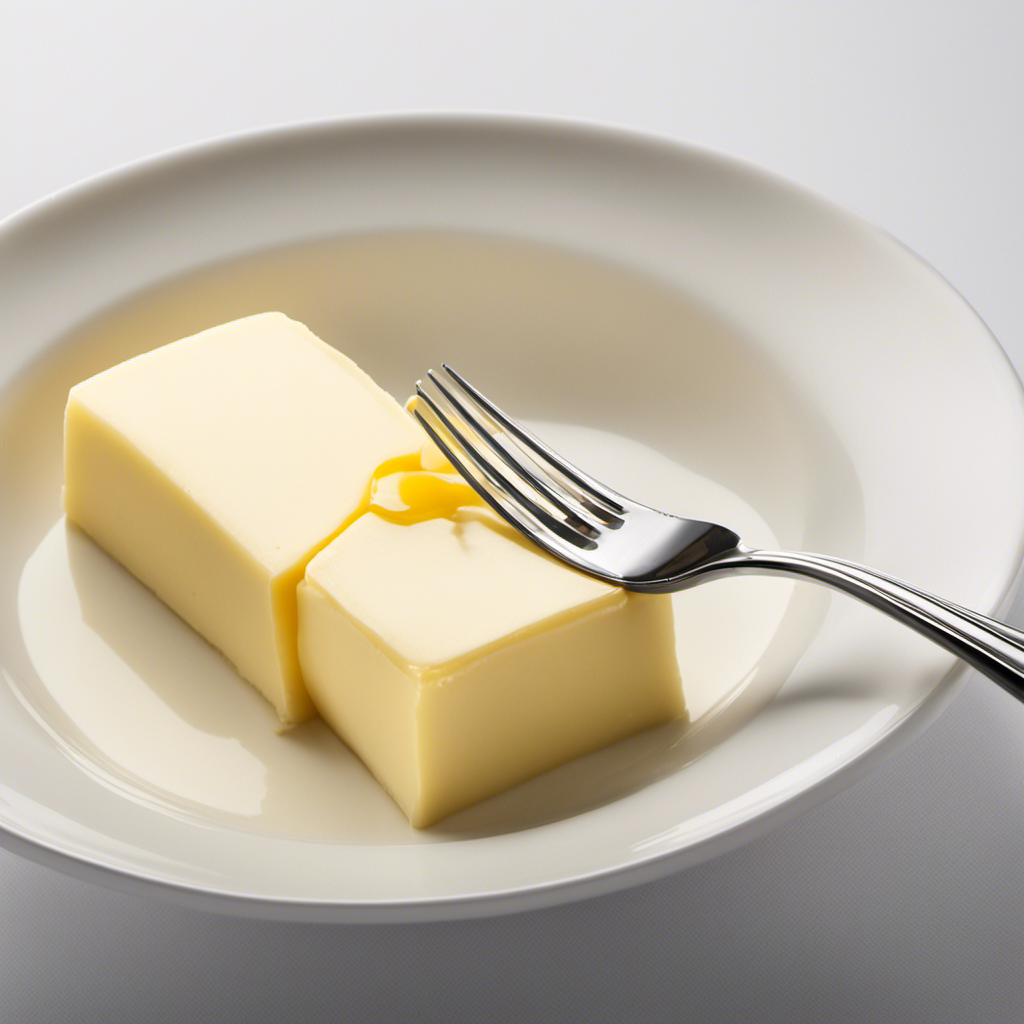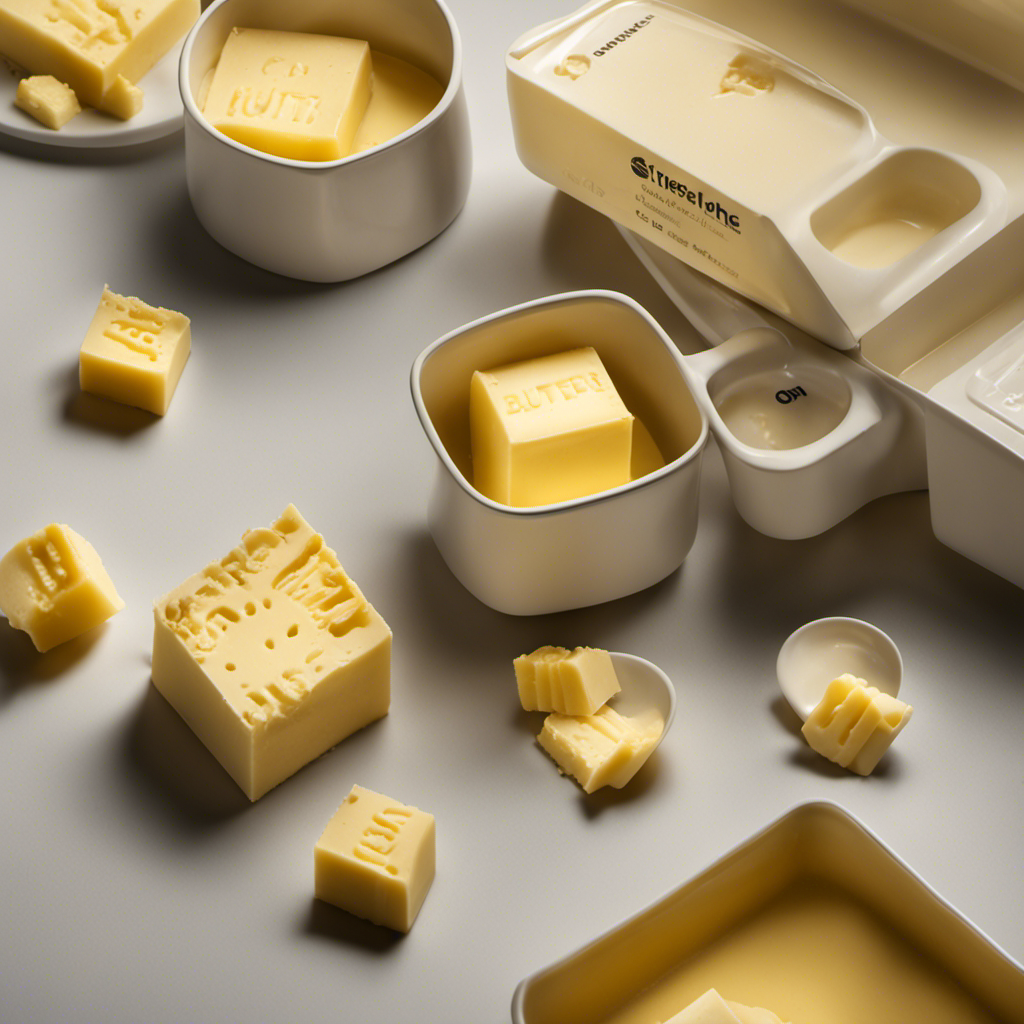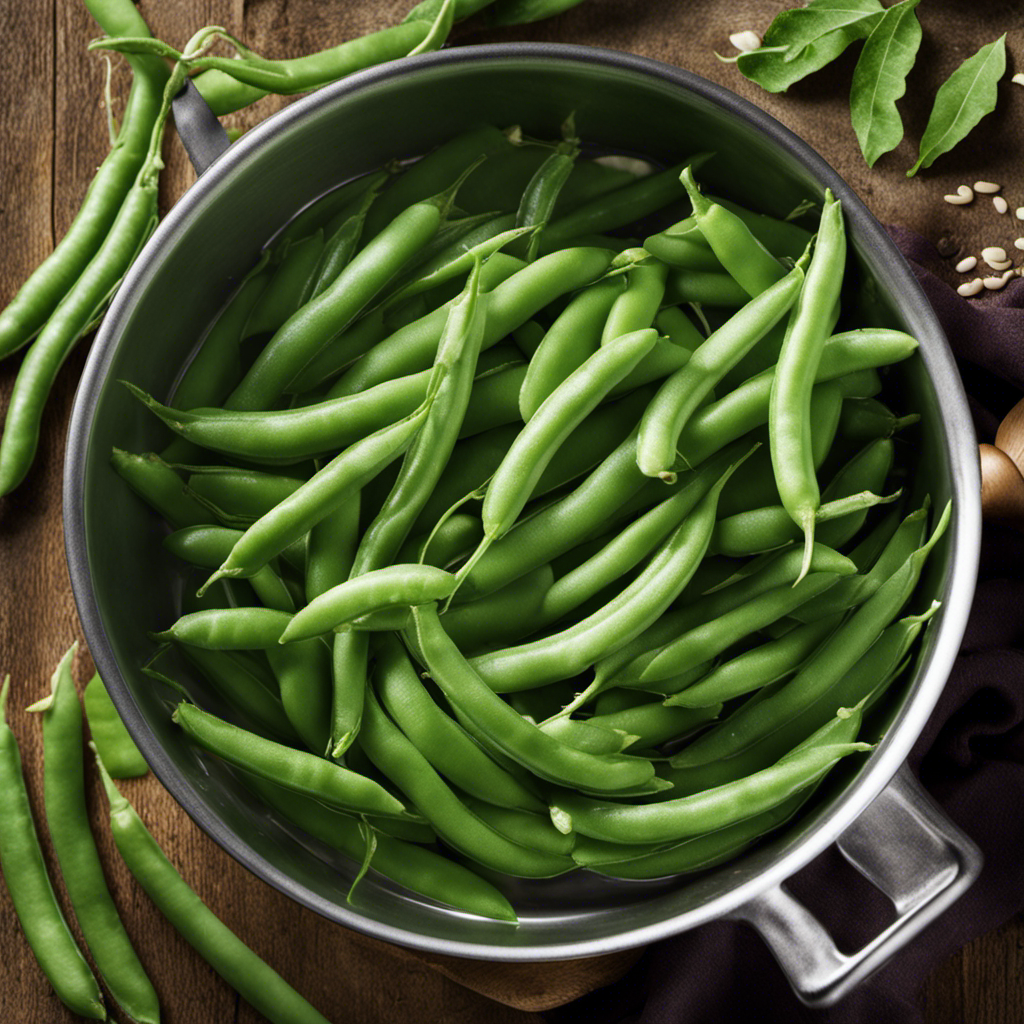I recall the first time I tried a recipe that required ‘1 stick of butter.’ Standing in my kitchen, holding the stick, I suddenly realized I had no clue how many tablespoons that equated to. It was a moment of perplexity and annoyance.
If only I had known then what I know now: 1 stick of butter equals 8 tablespoons. In this article, I will provide you with a handy butter conversion chart, tips for measuring butter accurately, and insights into common recipes and baking with butter.
Say goodbye to kitchen confusion and let’s dive into the world of butter measurements!
Key Takeaways
- A stick of butter is equal to 8 tablespoons.
- Converting between butter and tablespoons is essential for accurate measurements.
- Calculating tablespoons from butter can be done by dividing the amount of butter by 8.
- The standard ratio is 1 stick of butter equals 8 tablespoons.
The Basics: Understanding Butter Measurements
Understanding butter measurements can be confusing, but it’s important to know that a stick of butter is equal to 8 tablespoons.
When it comes to baking, recipes often call for butter in different measurements, and it’s helpful to know how to convert them accurately.
For example, if a recipe calls for 1/2 cup of butter, you can easily convert it to tablespoons by multiplying 1/2 by 8, which equals 4 tablespoons.
Similarly, if a recipe requires 1/4 cup of butter, you can convert it to 2 tablespoons.
It’s also important to note that butter can be measured in different forms, such as sticks, cups, or grams.
Understanding these butter measurement equivalents will allow you to confidently convert butter for baking and ensure your recipes turn out just right.
Butter Conversion Chart: Sticks to Tablespoons
To convert sticks of butter to tablespoons, it’s helpful to know that there are 8 tablespoons in one stick. Understanding butter tablespoon equivalents is essential for accurate measurements in recipes. Here is a handy butter conversion chart that shows the number of tablespoons in different quantities of butter:
| Sticks of Butter | Tablespoons |
|---|---|
| 1 | 8 |
| 2 | 16 |
| 3 | 24 |
As you can see, each stick of butter is equivalent to 8 tablespoons. So, if a recipe calls for 2 sticks of butter, you will need 16 tablespoons. This conversion chart simplifies the process of converting butter measurements, ensuring that you add the right amount to your recipes. Now that we have established the butter tablespoon equivalents, let’s move on to how to measure butter in tablespoons.
How to Measure Butter in Tablespoons
When it comes to measuring butter in tablespoons, it’s important to understand the conversion ratios and how to calculate the number of tablespoons from a given amount of butter.
The butter to tablespoon ratio can vary depending on whether you’re using sticks of butter or cups of butter.
To ensure accurate measurements in your recipes, knowing how to convert between butter and tablespoons is essential.
Butter Tablespoon Conversion
The stick of butter equals how many tablespoons?
When it comes to butter measurement equivalents, it’s important to know the conversions for different units. In the United States, a standard stick of butter is equivalent to 8 tablespoons or 1/2 cup. This measurement is widely used in recipes and makes it easier to portion out the butter.
However, if you’re using a different measuring system, such as metric, the conversion may vary. In the metric system, 1 stick of butter is approximately 113 grams or 4 ounces. It’s always a good idea to double-check the conversions based on your specific measuring system to ensure accuracy in your recipes.
Now that we know how many tablespoons are in a stick of butter, let’s move on to calculating tablespoons from butter.
Calculating Tablespoons From Butter
Calculating tablespoons from butter can be done by dividing the amount of butter by 8.
When it comes to measuring butter accurately, it’s important to have the right conversion. Butter is often sold in sticks, which are typically labeled with tablespoon measurements. However, if you have butter in a different form, such as a tub or a block, you may need to determine how many tablespoons are in a given amount.
To convert the measurements, simply divide the amount of butter by 8. For example, if you have 1 cup of butter, you would divide it by 8 to get 1/2 cup, which is equivalent to 8 tablespoons.
This simple calculation allows you to accurately measure butter in tablespoons, ensuring precise results in your recipes. Understanding this butter to tablespoon ratio is essential for successful cooking and baking.
Butter to Tablespoon Ratio
Converting butter into tablespoons is a simple process that can be achieved by dividing the amount of butter by 8. This conversion is commonly used in recipes, where specific measurements are necessary for accurate results.
Here are some key points to keep in mind when converting butter measurements:
- The standard ratio is 1 stick of butter equals 8 tablespoons.
- If you have a different amount of butter, divide it by 8 to determine the number of tablespoons.
- For example, if you have 2 sticks of butter, you would have 16 tablespoons.
- It’s important to note that butter can be measured in different ways across countries, so be sure to check the specific conversion for your region.
Quick Tip: Converting Sticks of Butter to Tablespoons
When it comes to measuring butter, understanding the conversions can make a big difference in your cooking.
One common question is how many tablespoons are in a stick of butter.
In this discussion, we will explore butter measurement conversions, the number of tablespoons in a stick of butter, and provide some quick kitchen conversions to help you in your culinary endeavors.
Butter Measurement Conversions
To figure out how many tablespoons are in a stick of butter, you can simply divide it by 8. This is a common measurement conversion used in cooking and baking. Here are some other butter measurement equivalents to keep in mind:
- 1 stick of butter = 8 tablespoons
- 1/2 stick of butter = 4 tablespoons
- 1/4 stick of butter = 2 tablespoons
- 1/8 stick of butter = 1 tablespoon
Knowing these conversions can be helpful when following recipes or adjusting measurements. Understanding how much butter is needed can ensure the right texture and flavor in your dishes.
Now that we know how many tablespoons are in a stick of butter, let’s explore more about the versatility of this ingredient and its importance in various recipes.
Tablespoons per Stick
If you’re unsure of the measurement, 8 tablespoons is the equivalent of one stick of butter. Converting butter to tablespoons can be helpful when following a recipe that calls for a specific amount of butter. Here is a table showing the butter measurement equivalents in tablespoons:
| Sticks of Butter | Tablespoons |
|---|---|
| 1 | 8 |
| 2 | 16 |
| 3 | 24 |
Quick Kitchen Conversions
By using a conversion chart, you can easily determine the equivalent measurements for common kitchen ingredients.
Here are some quick kitchen tips for converting grams to tablespoons:
-
Butter: 1 tablespoon is equivalent to 14 grams. So, if a recipe calls for 100 grams of butter, you would need approximately 7 tablespoons.
-
Flour: 1 tablespoon of flour weighs around 8 grams. If you have 50 grams of flour, that would be approximately 6 tablespoons.
-
Sugar: 1 tablespoon of sugar is roughly 12 grams. So, if you need 75 grams of sugar, you would need approximately 6 tablespoons.
-
Salt: 1 tablespoon of salt weighs approximately 18 grams. If you have 30 grams of salt, that would be around 1.5 tablespoons.
These conversions can be helpful when following recipes or adjusting measurements to suit your needs.
Common Recipes: Butter Measurements in Tablespoons
Did you know that in common recipes, a stick of butter is typically equal to 8 tablespoons? Understanding how to measure butter accurately is essential for successful baking. Here are some helpful tips and equivalents for measuring butter:
| Stick of Butter | Tablespoons | Cups |
|---|---|---|
| 1 | 8 | ½ |
| 2 | 16 | 1 |
| 3 | 24 | 1 ½ |
| 4 | 32 | 2 |
When a recipe calls for a specific amount of butter in tablespoons, it’s important to know the equivalent number of sticks needed. For example, if a recipe requires 12 tablespoons of butter, you would need 1 ½ sticks. Conversely, if a recipe calls for 3 sticks of butter, you would measure out 24 tablespoons.
Now that you know the butter measurement equivalents, let’s dive into the differences between using tablespoons and sticks of butter in baking.
Baking With Butter: Tablespoons Vs. Sticks
To accurately measure your butter for baking, you’ll want to know the difference between using tablespoons and sticks. Here are the benefits of using tablespoons for butter measurement:
-
Precision: Using tablespoons allows for more precise measurements compared to using whole sticks of butter. This is especially helpful when dealing with recipes that require specific ratios of ingredients.
-
Flexibility: Using tablespoons gives you the flexibility to add or subtract butter as needed, without having to worry about cutting a whole stick into smaller portions.
-
Convenience: Tablespoons are readily available in most kitchens, making it easy to measure out the exact amount of butter needed for your recipe.
-
Portion control: Using tablespoons helps you control the amount of butter you add to your baked goods, ensuring consistent results each time.
By understanding the benefits of using tablespoons, you can confidently measure your butter and achieve delicious results in your baking.
Now, let’s explore the handy conversion: sticks of butter to tablespoons for cooking.
Handy Conversion: Sticks of Butter to Tablespoons for Cooking
Now that we understand the difference between tablespoons and sticks of butter in baking, let’s talk about a handy tip for converting between the two measurements.
Sometimes a recipe might call for a certain number of sticks of butter, but you only have tablespoons on hand. Don’t worry, there’s an easy way to make the conversion!
One stick of butter is equal to 8 tablespoons. So, if your recipe calls for 2 sticks of butter, you can simply multiply that number by 8 to get the equivalent in tablespoons, which in this case would be 16 tablespoons.
This handy trick allows you to use alternative measurements without compromising the integrity of your recipe.
Frequently Asked Questions
Can I Use Margarine Instead of Butter in Recipes That Call for Tablespoons of Butter?
Yes, you can use margarine instead of butter in recipes that call for tablespoons of butter. To measure butter in tablespoons, 1 stick of butter equals 8 tablespoons.
How Do I Convert Tablespoons of Butter to Grams or Ounces?
To convert tablespoons of butter to grams or ounces, I would need to know the density of the butter. Without that information, I cannot provide an accurate conversion.
Are There Any Health Benefits to Using Butter Instead of Margarine or Other Substitutes?
There are health benefits to using butter instead of margarine or substitutes. Butter is a natural product with higher nutritional value and contains vitamins A, D, E, and K.
Can I Use Oil as a Substitute for Butter in Recipes That Call for Tablespoons of Butter?
Yes, you can substitute oil for butter in recipes that call for tablespoons of butter. However, keep in mind that the texture and taste of the final product may be different. There are also other alternatives to butter in baking, such as applesauce or mashed bananas.
How Long Does Butter Last in the Refrigerator Once It Has Been Measured Out in Tablespoons?
Once measured out in tablespoons, butter typically lasts in the refrigerator for about 1-2 weeks. To extend its shelf life, you can freeze butter measured out in tablespoons for up to 6 months.
Conclusion
In conclusion, understanding the conversion of butter measurements from sticks to tablespoons is essential for accurate and successful cooking and baking.
By referring to a butter conversion chart or using a simple calculation, you can easily determine the number of tablespoons in a stick of butter.
Interestingly, did you know that in the United States, a standard stick of butter is typically 1/2 cup or 8 tablespoons? This statistic highlights the convenience and consistency of using tablespoons as a measurement unit in many recipes.










